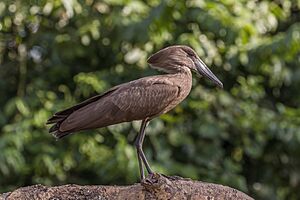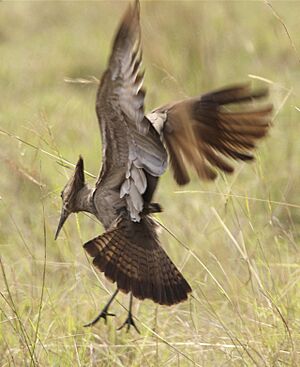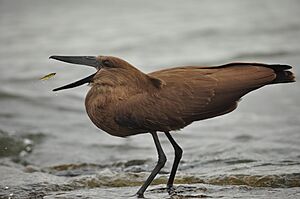Hamerkop facts for kids
Quick facts for kids Hamerkop |
|
|---|---|
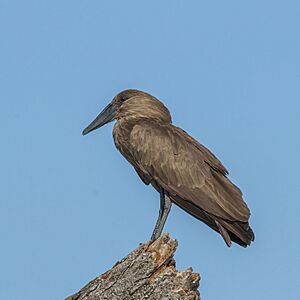 |
|
| In Kenya | |
| Conservation status | |
| Scientific classification | |
 |
|
| Range of the hamerkop |
The hamerkop (Scopus umbretta) is a medium-sized bird that wades in water. It is the only living species in its group, called Scopus, and its family, Scopidae. For a long time, scientists thought it was related to storks. Now, they believe it is closer to pelicans and the shoebill.
The hamerkop's head looks like a hammer. It has a long bill and a crest at the back. This unique shape gave the bird its name. "Hamerkop" comes from an Afrikaans word meaning "hammerhead". This bird has brown feathers. It lives in Africa, Madagascar, and Arabia. You can find it in many wet places. These include estuaries, lake shores, fish ponds, riverbanks, and rocky coasts. Hamerkops usually stay in one area.
Hamerkops eat many different things. They mostly catch fish and frogs. They also eat shrimp, insects, and small rodents. They usually hunt in shallow water. They find food by seeing it or by feeling it. This bird is very good at adapting. It will eat almost anything it can catch. Hamerkops are famous for building huge nests. They often build several nests during breeding season. Unlike most wading birds, their nest has a special room inside for the eggs. Both parents take care of the eggs and the chicks.
This bird is not in danger globally. There are many hamerkops in Africa and Madagascar. The International Union for Conservation of Nature (IUCN) says it is a species of least concern. This means it is not currently threatened.
Contents
About the Hamerkop's Name and Family
The hamerkop was first described by a French scientist named Mathurin Jacques Brisson in 1760. Later, another German scientist, Johann Friedrich Gmelin, officially named it Scopus umbretta in 1788.
The name Scopus comes from an ancient Greek word for "shadow". The name umbretta comes from a Latin word for "umber" or "dark brown". This describes the bird's color.
The hamerkop is so unique that it has its own family. For a long time, scientists were not sure where it fit in the bird family tree. They used to group it with storks. However, new studies show it is more closely related to pelicans and the shoebill. These three birds are now grouped together.
While the hamerkop is the only living member of its family, one extinct species has been found. This fossil bird, called Scopus xenopus, was a bit larger than today's hamerkop. Scientists think it might have spent even more time in the water.
The hamerkop has many other names. Some people call it the hammerkop, hammerkopf, hammerhead, hammerhead stork, umbrette, umber bird, tufted umber, or anvilhead.
Different Types of Hamerkops
Scientists recognize two main types, or subspecies, of hamerkops. The most common one is S. u. umbretta. The other is S. u. minor, which lives in West Africa. This type is smaller and darker.
Some scientists have suggested other types. Birds in Madagascar might be a distinct type called S. u. tenuirostris. Also, birds near the Kavango River in Namibia might be different. However, these are not officially recognized yet.
What Does a Hamerkop Look Like?
The hamerkop is a medium-sized waterbird. It stands about 56 centimeters (22 inches) tall. It weighs around 470 grams (1 pound). The S. u. minor subspecies is smaller.
Its feathers are a dull brown color. Its back feathers have a purple shimmer. The S. u. minor type is darker brown. Both male and female hamerkops look alike. Young birds look like adults.
The hamerkop has a long bill, about 8 to 8.5 centimeters (3.1 to 3.3 inches) long. The end of the bill is slightly hooked. It looks a bit like a shoebill's bill. It is quite thin, especially the lower part. Young birds have brown bills, but they turn black as the bird grows.
Its neck and legs are shorter than other similar birds. Its legs are black and have feathers only on the upper part. For some reason, hamerkops have partially webbed feet. The middle toe has a comb-like edge, similar to a heron's.
The hamerkop has a short tail. Its wings are large, wide, and rounded at the tips. It is good at soaring in the air. When it soars, it stretches its neck forward like a stork. But when it flaps its wings, it pulls its neck back like a heron. When it walks, it moves quickly and jerkily. Its head and neck move back and forth with each step. It might spread its wings out when running to help it balance.
Where Hamerkops Live
Hamerkops live in Africa south of the Sahara desert. They are also found in Madagascar and along the coast of southwest Arabia. They need shallow water to find food.
You can find them in all kinds of wet places. These include rivers, streams, temporary pools, estuaries, reservoirs, marshes, and even rice fields. In Tanzania, they have started feeding on rocky shores too. In Arabia, they live in rocky valleys with flowing water and trees.
Most hamerkops stay in their home areas. These areas are usually held by a pair of birds. Some hamerkops move to new places during the wet season. These birds are very comfortable around humans. They often feed and build nests in villages and other places built by people.
Hamerkop Behavior and Daily Life
Hamerkops are mostly active during the day. They often rest around noon when it is hottest. They can also be active around sunset. However, they do not hunt at night.
Social Life and Sounds
When a hamerkop is alone, it is usually quiet. But when they are in pairs or groups, they make many sounds. A lone hamerkop might make a sharp "nyip" or "kek" sound when flying.
In groups, hamerkops make different calls. These include cackles and rattling sounds. One special social call is the "yip-purr" call. This call is only made when at least three birds are together, sometimes up to 20. Birds start with "yip" calls. Then, they switch to purring sounds. They make this call with their necks stretched out. Sometimes they flap their wings. The more birds there are, the louder and more active the call becomes.
Another common social behavior is "false mounting". One bird stands on top of another, looking like it is mating. But they do not actually mate. This happens between mated pairs and also between birds that are not paired. It can even happen between birds of the same sex. Sometimes, females even mount males. Because of this, scientists think this behavior is social. It is not about mating.
Dominant birds might show they are in charge. They do this by opening their bills slightly and raising their crests. But generally, hamerkops are not very aggressive towards each other. Birds in groups also preen each other. One bird will offer its face or the back of its head to another bird to be cleaned.
Food and Feeding Habits
Hamerkops usually hunt alone or in pairs. But sometimes, they feed in large groups. They eat many different things. Frogs and fish are a big part of their diet. They also eat shrimp, insects, and small rodents. What they eat can change depending on where they live. For example, in East and Southern Africa, clawed frogs and tadpoles are important. In Mali, they mostly eat small fish. Because they eat so many different things, they do not need to hunt all day.
Their usual way of hunting is to walk in shallow water. They look for prey. If the water is clear, they hunt by sight. If the water is muddy, they put their open bill into the water or mud and then close it. They might shuffle one foot to stir up prey. Or, they might suddenly open their wings to scare prey out of hiding. If they catch prey in mud, they shake it to clean it. If there is clear water nearby, they might take the prey there to wash it.
Hamerkops also hunt while flying. A bird flies slowly over the water. Its legs dangle, and its head looks down. When it sees prey, it dips its feet down and hovers for a moment. Then, it snatches the prey with its bill and swallows it while still flying. This hunting method can be very successful. One bird caught prey in 27 out of 33 tries during a 45-minute hunt!
They are also good at finding easy meals. They eat termites when they swarm. They can catch many flying termites very quickly. Hamerkops have been seen hunting insects that are stirred up by grazing cattle and buffalo. This is similar to how cattle egrets hunt. They have also been seen fishing from the backs of hippos. Sometimes, they even hunt with banded mongooses. When mongooses hunted frogs in mud, hamerkops would catch frogs that escaped the mongooses.
Reproduction and Life Cycle
One of the most amazing things about hamerkops is their huge nests. These nests can be more than 1.5 meters (5 feet) wide. They are strong enough to hold a person's weight! Hamerkops usually build their nests in the fork of a tree, often over water. If there are no trees, they might build on a bank, a cliff, a human-made wall, or even on the ground.
A pair starts by making a platform of sticks held together with mud. Then, they build walls and a domed roof. There is an entrance hole at the bottom, about 13 to 18 centimeters (5 to 7 inches) wide. This leads through a tunnel up to 60 centimeters (2 feet) long. The tunnel opens into a nesting chamber. This room is big enough for the parents and their young.
Building a nest can take 10 to 14 weeks. One scientist thought a nest might need about 8,000 sticks or bunches of grass. Even after the nest is finished and eggs are laid, the parents might keep adding material. This extra material is often not sticks. It can be strange things like bones, animal skin, or even human trash.
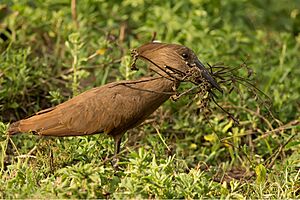
Hamerkop pairs love to build nests. They build three to five nests every year, whether they are breeding or not. Both birds in a pair help build the nest. Building nests might help them stay bonded as a pair.
Sometimes, Barn owls or eagle owls might take over a hamerkop nest. But when the owls leave, the hamerkops might use the nest again. Other animals also use abandoned nests. These include snakes, small mammals like genets, and various birds. Some birds, like weaver birds, starlings, and pigeons, might even attach their own nests to the outside of a hamerkop nest.
Hamerkops usually do not nest very close together. However, there are a few reports of them nesting in groups. In Uganda, 639 nests were seen in an area of 8 square kilometers (3 square miles). Even if each pair built seven nests, this would mean 80 pairs were nesting there. While they don't usually form large colonies, they are also not very territorial. Their home areas often overlap.
Hamerkops breed all year round in East Africa. In other places, breeding peaks at different times, often in the dry season. Pairs perform a breeding display. Then, they mate on the nest or nearby.
A female lays three to seven eggs. The eggs are chalky white at first. But they quickly get stained. On average, the eggs are about 44.5 x 33.9 millimeters (1.75 x 1.33 inches) and weigh about 27.8 grams (1 ounce). Egg size can vary depending on the season and how many eggs are in the clutch.
Both parents sit on the eggs to keep them warm. However, the female seems to do most of the work. Incubation takes about 30 days from when the first egg is laid. Eggs are laid every one to three days, so they hatch at different times.
Both parents feed the young. They often leave the chicks alone for long periods. This is unusual for wading birds. But the thick walls of the nest might make it safe for the chicks. When they hatch, the young birds are covered in grey downy feathers. By 17 days old, their head and crest feathers have grown. In a month, their body feathers are developed. They first leave the nest when they are about 44 to 50 days old. But they continue to use the nest to sleep at night until they are two months old.
Hamerkops and People
Many interesting stories and legends exist about the hamerkop. In some areas, people say that other birds help the hamerkop build its nest. The ǀXam people believed that if a hamerkop flew over their camp and called, it meant someone close to them had died.
In some cultures, it is known as the lightning bird. The Kalahari Bushmen believed that if you tried to steal from a hamerkop's nest, you would be struck by lightning. They also believed that their god Khauna would not like anyone who killed a hamerkop. An old belief among the Malagasy says that anyone who destroys its nest will get leprosy. A Malagasy poem even calls it an "evil bird". These kinds of beliefs have helped protect the bird. In South Africa, it has a name, Njaka, which means "rain doctor". This comes from its habit of calling loudly before it rains.
The name "Scopus" is also used for a large database of scholarly articles. A scientific journal about natural history in East Africa is also named Scopus. Both were named in honor of this unique bird.



